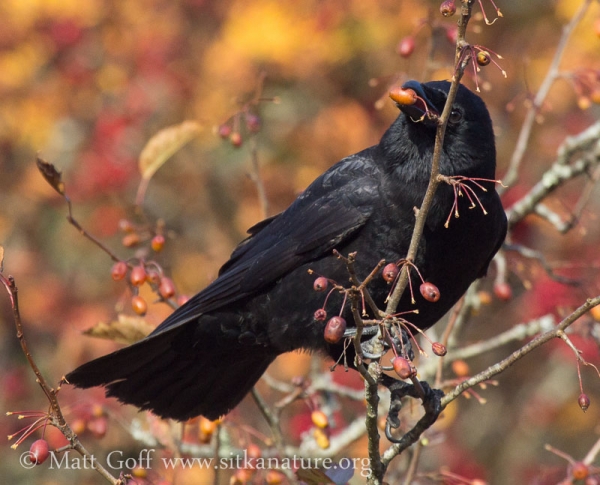A few days ago I noticed some crows perched in a crabapple (Malus fusca) loaded with fruit. They seemed fairly unconcerned with me, so I was able to watch and photograph as they pulled off the small fruits to eat. The native pacific crabapple fruits are small -about the size of the end of my finger. Like apples we’re generally familiar with, they are hard as they develop. However, at some point the flesh of the fruit liquefies inside the still tough skin and they become quite soft. I enjoy picking these soft fruits, as it is easy to suck out the tart juicy insides and then spit out the skin and seeds. (I don’t mind eating the skins if they haven’t turned dark and leathery with scabby looking spots, I suppose they probably wouldn’t hurt me, but I still spit them out.)
Fruit that haven’t softened up yet are usually difficult to detach from their stem, and not as enjoyable (for me) to eat. Watching the crows, it appears they have a similar taste in crabapples. In particular, in the first two images below, you can see a crow working on pulling off a still hard crabapple. In the third image, you see the apple dropping down, stem still attached. I’m not sure if this was intentional (though I suspect it was), and if so, what prompted the drop. At first I thought maybe it just didn’t want to eat a hard fruit, but then it occurred to me that the hardness of the fruit would be readily apparent from at least the first time it grabbed it with its beak (and generally it’s possible to tell just by looking). If it did decide it didn’t want a hard fruit, why bother working at getting it picked? Now I’m wondering if maybe it did not want to eat the stem along with the fruit, so once it saw the stem was still there, it let go.
Questions:
- What other animals eat crabapples?
- What other fruits to crows eat?
- What prompts the crabapple insides to liquefy? (maybe frost, but seems like they will do so even without)

